

The BLM invites the public to follow BLM Colorado’s Fire Facebook and Twitter pages. These new fire pages provide the public with current news on wildfire activity and suppression efforts, prevention tips, evacuations, alerts and information.
The public can subscribe to updates by clicking “like” on BLM Colorado’s Fire Facebook page: www.facebook.com/BLMColoradoFire.
To find region-specific information in Colorado, please use the following hashtags: Northwest Colorado #blmnwfire, Upper Colorado River #blmucrfire, Southwest #blmswfire, San Juan #blmsjfire, Front Range #blmfrfire, San Luis Valley #blmslvfire on BLM Colorado’s Twitter page: www.twitter.com/BLMColoradoFire.
The BLM Colorado completes about 11,900 acres of fuels reduction projects annually in the state. BLM Colorado focuses its fuels reduction efforts on areas near communities known as the Wildland Urban Interface (WUI). More information on BLM's fire program.
Meet Tina
The BLM Colorado State Office added a new Land Law Examiner
to their team, Tina Turja. Tina, (Christine)
is returning to the state office after leaving in 2000. While away from the BLM, Tina worked for
Texaco, Encana Oil & Gas and Noble Energy.
Currently, Tina and the rest of the staff are preparing for the May Oil and Gas Lease Sale.
Colorado is home to Tina; she is from Pueblo and graduated from the University in Boulder. Tina is
looking forward to the annual golf tournament this summer and opportunities to
travel. The staff at the Colorado State
Office is happy to have Tina back.

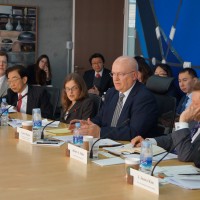
Lonny Bagley, speaks to group in South Korea
BLM Colorado Participation in Korean Shale Gas Workshop
by Public Affairs Specialist, Vanessa Lacayo
The Bureau of Land Management in Colorado recently participated in a workshop in Seoul, South Korea, to discuss shale gas development and share information about the BLM’s leasing and permitting process tied to hydraulic fracturing.
“The workshop focused on how oil and gas leasing, permitting and development may play out and influence the future of shale gas development in the United States, and its subsequent implications for South Korea’s future energy outlook,” Bagley said.
"The
workshop focused on how oil and gas leasing, permitting and development may
play out and influence the future of shale gas development in the United
States, and its subsequent implications for South Korea’s future energy
outlook,” Bagley said.
Bagley’s visit was coordinated through the BLM national office and the Department of the Interior. Bagley was joined by two other panelists from the United States. James A. Slutz, president and managing director for Global Energy Strategies, LLC., provided an industry perspective on shale gas development and advancements in hydraulic fracturing. Hannah Wiseman, assistant professor for Florida State University College of Law, presented information on how
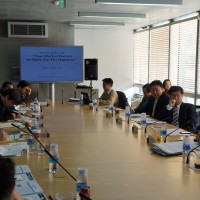

Lonny Bagley represents BLM Colorado during a workshop in South Korea
state governments address issues tied to shale gas development and hydraulic fracturing.
South Korea is the world’s second largest net importer of liquefied natural gas and coal, the fourth largest of iron ore and fifth for oil. As of 2012, the Korea National Oil Corp has invested more than $2 billion on shale gas assets in the United States. The Korea Gas Corp also announced its intention to invest in American shale gas assets that would lead to another 3 million metric tons of imports a year. Currently, the discussion in Korea on this topic has focused on the economic and technical aspects of hydraulic fracturing. The BLM’s participation was simply to present information on managing energy resources on federally-owned public lands.


Rare fish discovery shedding light on endangered fish
ecology
BLM Colorado Fishery Biologist Tom Fresques wasn’t sure what
he would find when he began the first intensive sampling of Yellow Jacket Canyon
in southwestern Colorado, but he certainly didn’t think he would find one of
the most endangered fish in the Colorado River Basin.
The single specimen Tom and the summer wildlife crew from the Tres Rios Field Office found that summer morning in 2007 is helping shed new light on the ecology of Colorado pikeminnow, information that may prove important in the recovery of the species.
Tom’s findings, published this month in Southwestern Naturalist, highlight the important field work BLM’s specialists and seasonals conduct each year to inventory and monitor the biological resources found on BLM lands.
The project also underscores the importance to BLM of
interagency partnerships and coordination.
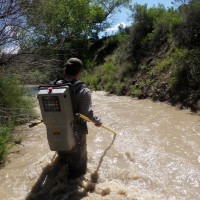

Tom wasn’t sure what they would find because this was the
first recent intensive sampling of the creek, but Colorado pikeminnow were far
from his mind.
“When you are running a transect, it’s pretty hot and heavy,” Tom says. “It was pretty clear we were finding a healthy native fishery during our sampling effort, but until we finished and began working up the fish, we hadn’t noticed anything unusual."
Once the biologists completed their transect, they began identifying
and measuring the fish before returning them to the creek. They caught about
100 fish, ranging in size from about 2 inches to 12 inches. Most were speckled
dace, flannelmouth suckers and other native fish including the targeted
roundtail chub, although a few introduced species like red shiners and channel
catfish were also captured.
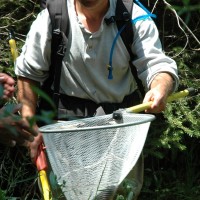
The pikeminnow they captured was just under 8 inches, and
hadn’t stood out in a bucket of many larger fish.
In 2010, Tom conducted the surveys with the help of a “PIT-tag”
reader, which would detect the electronic chips placed in some of the pikeminnow
that had been hatchery-raised and released in the San Juan River Basin. Of the
six pikeminnow they captured that year, one had a PIT-tag. Based on the tag information, the fish had
been stocked in the San Juan River two years before, more than 50 miles from
where Tom captured it.
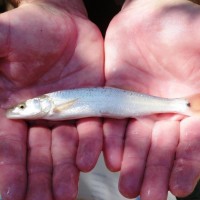

In 2010, Tom conducted the surveys with the help of a “PIT-tag”
reader, which would detect the electronic chips placed in some of the pikeminnow
that had been hatchery-raised and released in the San Juan River Basin. Of the
six pikeminnow they captured that year, one had a PIT-tag. Based on the tag information, the fish had
been stocked in the San Juan River two years before, more than 50 miles from
where Tom captured it.
Continuing to study how Colorado pikeminnow might use smaller tributaries may provide valuable insights into the life history of this species, which could assist with continued management-
and recovery efforts within the San Juan River and beyond.This is very gratifying for Tom, who began his fisheries career in the late 1980s working with Colorado pikeminnow.
“The lesson this really brings home to me is the importance of getting in the field so I am well-versed in the resources we manage,” Tom says. “As this shows, you may not know what’s out there if you can’t get out and look.”
Tom’s Southwestern Naturalist article is available at the BioOne website, http://www.bioone.org/toc/swna/58/1.

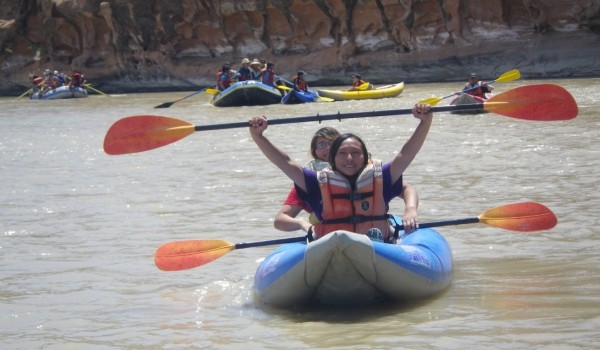
Diné College partnered with Colorado’s Uncompahgre Field
Office river ranger crew to provide overnight float trips on the Gunnison River
for underserved youth as part of the Take It Outside Program.
Hands on the Land is a nation-wide network of field classrooms connected through the Internet. You can learn about Colorado’s prominent role in the “bone wars” through the Royal Gorge Field Office’s Hands on the Land Program. More BLM sites are being added to the Hands on the Land Network annually.
Planning a road trip with the family? Check out our Junior Explorers program, where kids learn about public lands through activity books. BLM Colorado has Junior Explorer activity books for the Alpine Loop, the Anasazi Heritage Center and the Arkansas River Headwaters Recreation Area, and is in the process of developing Junior Explorer books for the Uncompahgre Field Office and the Grand Junction Field Office.
BLM’s Take It Outside program promotes and
supports outdoor activities and the experiences of children on public lands.
This program strives to improve the health of our nation's children, families,
and communities, while at the same time developing the next generation of
public land stewards.